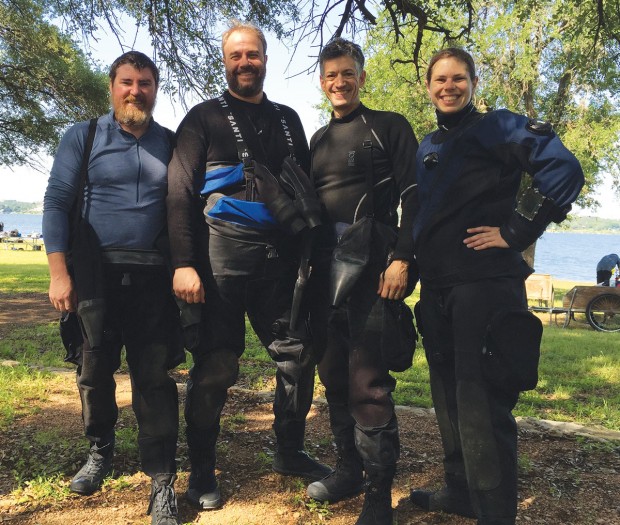Scuba diving in Texas

Todd Blitzer lived in California for several years after he and his wife Andy graduated from UT Austin, and he used to love diving in the kelp forests located off the coast. He’d go spear fishing and abalone and lobster hunting; the reefs off the coast of California were teeming with life.
“It’s spiritual and it’s surreal; it’s the only way to describe that underwater forest,” he said.
In 1991 they moved back to Texas. Todd wanted to keep diving so he went on a boat trip out to an old oil rig; the choppy waters led him to an awful experience, and he vowed to never repeat it. He went diving in Cozumel, in the Red Sea, and back in California. Twenty-four years would go by before one day last March, when he made a stop at the Gigglin’ Marlin Dive and Swim shop where his son, Devin, and daughter, Greer, learned to dive. The team there had organized a trip that would entirely change his way of thinking about diving.
Gigglin’ Marlin organizes dives all over the world, from Norway to Indonesia. But today they were talking about Spring Lake – the old Aquarena Springs near San Marcos. The unique environment is fragile and divers must take a special course. Todd signed up.
“It turns out Spring Lake is the headwaters of the San Marcos River, and it’s also at the base of the Hill Country’s Balcones Fault,” he said. It’s clear as an aquarium and fed by hundreds of springs from the Edwards aquifer that bubble up through the sand like tiny geysers. Its underwater forest includes salamanders and fish only found in this spring. It’s also an archaeological site where some of the oldest known records of man have been identified.
Here visitors ply the waters in glass-bottomed boats as they have since 1945, observing the aquatic life. And divers like Todd – who, as regular volunteers, actually became a part of the tour as they go about their work – are taught to remove invasive non-native species and massage the bottom of the artesian springs to clear away debris and help the water come in.
Here at Spring Lake Todd met Sam Meacham, former research scientist and diving safety officer at Texas State University and instructor with Global Underwater Explorers (GUE), who taught him a more technical, more conservation-oriented approach. “He got me interested in a whole different way of diving … you control your buoyancy so you do not impact the environment at all. You’re completely horizontal, and you don’t touch anything – so you are respectful toward the biology that exists.”
The Texas diving community turned out to be enormously friendly and collegial, and with more of an emphasis on technical diving – challenging oneself to exercise more control of one’s buoyancy and trim, develop better air-consumption rates, learn greater management of the equipment and the body. Todd’s goal is to eventually be able to pass the Fundamentals Tech Pass certification with GUE, which opens the way to participation in GUE’s Baseline programs for conservation volunteerism, monitoring different habitats to measure the impact on aquatic environments by man and the impacts of climate change, for example. In addition, greater proficiency opens up opportunities for diving in overhead environments such as underwater caverns, caves and shipwrecks.
The second big discovery was Flower Garden Banks National Marine Sanctuary. This preserve is a remote triad of coral reefs five hours off the coast, teeming with manta rays, whale sharks, hammerheads, coral heads as big as cars and a stunning diversity of tropical fishes.
“There are few places in the world like that – it’s really quite incredible,” said Todd. “One lobster we saw must have been 3 feet long. Life can thrive because you’re in the middle of nowhere; it’s not overfished, it’s not over-dove – because it’s so difficult to get to, people haven’t had a chance to destroy it.”
The excursion typically sets off the night before, and you spend the day diving; there are a number of different charters that leave from Freeport, Galveston or Sabine Pass. Night diving is an outstanding experience, as well. The dive guide dropped some strobe lights with an anchor line to make the boat easy to find on their return. “If you turn off your dive light and let your eyes adjust to the darkness, the whole area lights up like a Christmas tree…. the bioluminescence was unbelievable. It was like being in Avatar.”
Texas is a treasure trove of dive spots
There’s no need to jet off to Cancún or the Caymans if your goal is underwater adventure. Indeed, people travel to the Galapagos and to Hawaii to see some of the rare sea life that you can find at Flower Garden National Marine Reserve off the Texas coast. Flower Garden is the rival of any reef anywhere, says veteran diver Todd Blitzer. Crystal-clear Spring Lake is home to an enchanted underwater forest of an entirely different sort. But Texas offerings are diverse and many – and, if your goal is like Todd’s, to improve your skills, there are lots of places close to home where you can get the job done and enjoy the varied Lone Star landscape while you’re at it.
Here are a few of his suggestions:
The Texas Clipper, a shipwreck off the coast of South Padre, which offers a fascinating multi-level dive with divers at every skill level. http://www.texashighways.com/travel/item/531-dive-in-south-padre-island
The crystalline springs at Balmorhea State Park, north of Big Bend in West Texas. http://www.texashighways.com/wild/item/528-dive-in-balmorhea-state-park
Closer to home is 288 Lake, a quarry-turned-park where triathletes often go to train. http://288lake.net/scuba-diving/
Lake Travis in Austin is home to a variety of popular dive spots: http://www.scubaland.com/dive-club/local-diving/126-lake-travis-dive-sites
At Canyon Lake, you can even sign up to help seek out, map and explore two settlements that were flooded back in the 1960s. http://www.canyonlakedivers.com/lakediving.html
Blue Lagoon in Huntsville has excellent visibility when the conditions are right, but there’s not much aquatic life.
http://www.bluelagoonscuba.net/
Mammoth Lake, a scuba diving lake and waterpark, is located in Lake Jackson.
http://mammothlakewaterpark.com/
The idea of doing more diving closer to home, however, emphasizes Todd, is to focus more on improving technique, as opposed to sightseeing.
“What I like is pushing for excellence, and as you get better, it becomes less about you and more about others,” he said. “You become more aware and more able to help.”
In a way, this new direction is taking him back to the road not taken, he said. When he was in high school and looking for his life path, he was divided between studying marine biology and architecture; he ended up choosing the latter. To now be able to go back and incorporate one of his initial interests is “sort of like having my cake and eating it, too.”
Over the years he has become increasingly aware of the need for conservation in the aquatic environments where he dives, another motivation for increasing his diving skills to be able to contribute to work being done in that area.
“In Texas, around the country and internationally, there is a need for balance between the aquatic life that exists and needs to thrive and the use of the rivers, lakes, and oceans for recreation, commerce and transportation,” Todd explains in an e-mail. “Being aware that there are whole ecosystems teeming with life that exist in an often unseen underwater world that must be protected and sustained in all types of bodies of water is the first step.”
In particular, he added, the conservation of Spring Lake in the Texas Hill Country, San Solomon Spring at Balmorhea State Park in West Texas, and the Flower Gardens in the Gulf of Mexico help to ensure that these aquatic microsystems are able to survive and thrive naturally, without having to try to adapt or suffer permanent damage. “This is extremely important for the balance of the beautiful diversity of aquatic biology that exists in our world for current and future generations to come.”
Apart from the Flower Gardens, local diving might not be quite as spectacular as what you’ll see in the tropics, he says, but it has its own splendor. “It’s a different perspective – you’re looking at more of a micro level rather than a macro level. It’s beautiful and vast and easy to get to… it’s local, and you don’t have to jump on a plane to go somewhere. Cozumel or California diving is fantastic, but that’s not where we are.”
Texas diving video and articles
First-rate video and good reporting on Texas dive spots and on technical and conservation-oriented diving – guaranteed to make you want to get up out of that armchair and out into the water.
Spring Lake
Exploring Ancient Springs in Texas: A National Geographic video. Researchers are exploring freshwater springs in Texas that date back to the end of the last ice age. Spring Lake, near San Marcos, Texas, is unique because it was dammed 150 years ago, creating an underwater archaeological preserve. https://www.youtube.com/watch?v=fQIvdlzdqeE
Spring Lake Volunteer Dive, by the FrogKickers: Divers are tasked with cleaning the invasive plants from the lake to keep the ecosystem healthy. Video explains volunteers’ task for that day: to tour the lake and familiarize themselves with it, and to clean Deep Hole and Cream of Wheat. https://www.youtube.com/watch?v=rXzbx7ozaII
The Meadows Center for Water and the Environment, Texas State University. https://www.youtube.com/watch?v=nWA_hL8zjN8
Flower Gardens National Marine Reserve
Explore the “Texas Caribbean” at Flower Garden Banks – Video by Texas Dive Center. https://www.youtube.com/watch?v=xE5UhHvqadg
Researchers at Texas A&M University share experiences and knowledge. https://www.youtube.com/watch?v=1QYIQyIRYxE
Texas Gulf Treasures – Diving the Flower Gardens Banks National Marine Reserve, by Geoff Burke.
https://www.youtube.com/watch?v=PK6TAhGEgvY
Texas Highways article on diving in Flower Gardens. http://www.texashighways.com/travel/item/530-dive-in-flower-gardens-bank...
Buoyancy and Trim
John Kendall and GUE-UK look at two basic finning techniques – Frog Kick and Flutter Kick, two methods of propulsion that enables divers to get closer to the bottom without stirring up silt or otherwise impacting the environment. https://www.youtube.com/watch?v=U5wliityRuU&list=PL4usrVwAi8yxbJnCjf06aO...
Essentials of Technical Diving. https://www.youtube.com/watch?v=a-p7Pm0tSWM
Good buoyancy and trim are essential skills a technical diver requires to dive in overhead environments. This level of control helps reduce workload and CO2 production and makes for an efficient, streamlined diver in the water. https://www.youtube.com/watch?v=WFKQmjbwIH0
Diving the Texas Clipper
Texas Parks and Wildlife sank a 7,000-ton ship 17 nautical miles off the coast of South Padre Island to create an artificial reef on the barren sandy bottom of the Gulf of Mexico. It has become a haven for marine life, anglers and divers. https://www.youtube.com/watch?v=Q97IAUHICjo
The USTS Texas Clipper: A New Artificial Reef in the Gulf of Mexico, Texas Parks and Wildlife. http://tpwd.texas.gov/fishboat/fish/didyouknow/txclipper.phtml
Scuba Diving Magazine travel feature on The Texas Clipper. http://www.scubadiving.com/travel/south/texas-clipper
Texas diving pioneer Jennifer Idol
Texas diver Jennifer Idol’s book, An American Immersion: How the first woman to dive all 50 states was transformed by her quest. Idol, pictured with Todd Blitzer in this article’s lead photo, is a member of SCUE (South Central Underwater Explorers) and a professional photographer: http://www.theunderwaterdesigner.com, http://www.amazon.com/American-Immersion-first-states-transformed/dp/1930536917?ie=UTF8&psc=1&redirect=true&ref_=oh_aui_detailpage_o01_s00
Want more buzz like this? Sign up for our Morning Buzz emails.
To leave a comment, please log in or create an account with The Buzz Magazines, Disqus, Facebook, or Twitter. Or you may post as a guest.



